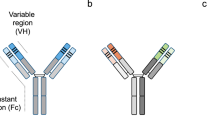Summary
Monoclonal antibodies (mAbs) BW 625 and BW 704, of the IgG3 isotype, bound to immunochemically indistinguishable epitopes on ganglioside II3(NeuAc)2-GgOse3-Cer. Despite this fact the mAbs showed a differential binding pattern on human glioma cell lines i.e. immunohistochemical data indicate that the detected epitopes are not identical. Furthermore, either mAb is able to mediate the antibody-dependent cellular cytotoxicity reaction (ADCC) and the human-complement-dependent cytotoxicity reaction (CDC) with epitope-expressing tumor cells. All cryopreserved tissue specimens from gliomas and neuroblastomas were immunohistochemically stained, whereas the other small round cell tumors of childhood, as well as melanomas and small-cell lung carcinomas, were essentially negative. Positive staining of normal cryopreserved tissues was restricted to amyelinic axons, Hassal's bodies and some connective tissue fibers in thymus and the tegumentary epithelium of skin. The high selectivity of mAb BW 704 for gliomas and neuroblastomas, the lack of cross-reactivity with major tissues and the strong ADCC and CDC potential argue for the use of mAb BW 704 in immunotherapy of neuroblastomas and gliomas.
Similar content being viewed by others
References
Bosslet K, Lüben G, Stark M, Sedlacek HH (1984) Molecular characteristics of two lung carcinoma cell line associated membrane antigens. Behring Inst Mitt 74:27
Bosslet K, Kanzy EJ, Lüben G, Sedlacek HH (1986) A homogeneously expressed pancarcinoma epitope, Abstr 5th NCI/EORTC Symposium on New Drugs in Cancer Therapy, Amsterdam, Oct. 23–24
Brown JP, Klitzmann JM, Hellström KE (1977) A microassay for antibody binding to tumour cell surface antigens using 125I-labelled protein A from Staphylococcus aureus. J. Immunol Methods 15:57
Cheung NKV, Saarinen UM, Neely JE, Landmeier B, Donovan D, Coccia PF (1985) Monoclonal antibodies to a glycolipid antigen on human neuroblastoma cells. Cancer Res 45:2642
Cheung NKV, Lazarus H, Miraldi FD, Abramowsky CR, Kallick S, Saarinen UM, Spitzer T, Strandjord SE, Coccia PF, Berger NA (1987) Ganglioside GD2 specific monoclonal antibody 3F8: phase I study in patients with neuroblastoma and malignant melanoma. J Clin Oncol 5:1430
Cordell JL, Falini B, Erber WN, Gash AK, Abdulaziz Z, Macdonald S, Pulford KAF, Stein H, Mason DY (1984) Immunoenzymatic labeling of monoclonal antibodies using immune complexes of alkaline phosphatase and monoclonal antialkaline phosphatase. J Histochem Cytochem 32:219
Dippold WG, Dienes HP, Knuth A, Meyer zum Büschenfelde KH (1985) Immunohistochemical localization of ganglioside GD3 in human malignant melanoma, epithelial tumors and normal tissues. Cancer Res 45:3699
Gatter KC, Cordell JL, Fami B, Ghosh AK, Heryet A, Nash JRG, Pulford KA, Moir J, Erber WN, Stein H, Mason DY (1983) Monoclonal antibodies in diagnostic pathology: techniques and applications: J Biol Response Mod 2:369
Hacker WG, Springall DR, Van Noorden S, Bishop AE, Grimelius L, Polak JM (1985) The immunogold-silver staining method. A powerful tool in histopathology. Virchows Arch [A] 406:449
Harpin ML, Coulon-Morelec MJ, Yeni P, Danon F, Baumann N (1985) Direct sensitive immunocharacterization of gangliosides on plastic thin layer plates using the peroxidase staining. J Immunol Methods 78:135
Houghton AN, Mintzer D, Cordon-Cardo C, Welt S, Fliegel B, Vadhan S, Carswell E, Melamed MR, Oettgen HF, Old LJ (1985) Mouse monoclonal antibody detecting GD3 ganglioside: a phase I trial in patients with malignant melanoma. Proc Natl Acad Sci USA 82:1242
Joseph K, Höffken H, Damann V (1987) In vivo labelling of granulocytes using 99mTc-labelled monoclonal antibodies: first clinical results. Compact News for Nuclear Medicine 18:223
Katano M, Saxton RE, Irie RF (1984) Human monoclonal antibody to tumor-associated ganglioside GD2. J Clin Lab Immunol 15:119
Klenk E (1968) Über eine Komponente des Gemisches der Gehirnganglioside, die durch Neuraminidaseeinwirkung in das T-Sachs Gangliosid übergeht. Hoppe-Seyler's Z Physiol Chem 349:288
Klöppel G, Caselitz J (1987) Epithelial tumor markers: oncofetal antigens (carcinoembryonic antigen, alpha fetoprotein) and epithelial membrane antigen. Curr Top Pathol 77:103
Köhler G, Milstein C (1975) Continuous cultures of fused cells secreting antibody of predefined specificity. Nature 256:495
Ladisch S, Wu ZL (1985) Detection of a tumour-associated ganglioside in plasma of patients with neuroblastoma. Lancet II. 136
Mach JP, Chatal JF, Lumbroso JD, Buchegger T, Forni M, Ritschard J, Berche Ch, Douillard JY, Carrel S, Herlyn M, Steplewsky Z, Koprowski H (1983) Tumor localization in patients by radiolabelled monoclonal antibodies against colon carcinoma. Cancer Res 43:5593
Magnani JL, Brockhaus M, Smith DF, Ginsburg V (1982) A monosialoganglioside is a monoclonal antibody-defined antigen of colon carcinoma. Science 212:55
Mennel HD, Zinngrebe J, Berweiler-Nippert U, Lorenz H (1988) Meningiomas: histogenesis and classification. A comparative morphological study. Zentralbl Allg Pathol 134:27
Ouchterlony O (1948) Antigen antibody reactions in gels. Ark Mineral Geol 26B:1
Reinherz EL, Kung PC, Goldstein G, Schlossman SF (1979) Separation of functional subsets of human T cells by a monoclonal antibody. Proc Natl Acad Sci USA 76:4061
Schulz G, Bumol TF, Reisfeld RA (1983) Monoclonal antibody directed effector cells selectively lyse human melanoma cells in vitro and in vivo. Proc Natl Acad Sci USA 80:5407
Schulz G, Cheresh DA, Varki NM, Yu A, Staffileno LV, Reisfeld RA (1984) Detection of ganglioside GD2 in tumor tissues and sera of neuroblastoma patients. Cancer Res 44:5914
Seybold K, Locher TJ, Coosemans C, Andres RY, Schubiger AP, Bläuenstein P (1988) Immunoscintigraphic localization of inflammatory lesions: clinical experience. Eur J Nucl Med 13:587
Shulman M, Wilde CD, Köhler G (1978) A better cell line for making hybridomas secreting specific antibodies. Nature 276:269
Tai T, Kawashima I, Tada N, Ikegami S (1988) Different reactivities of monoclonal antibodies to ganglioside lactones. Biochim Biophys Acta 958:134
Wiegandt H (1973) Gangliosides of extraneural organs. Hoppe-Seyler's Z Physiol Chem 354:104
Workshop on Gangliosides and Cancer, Nonnweiler, FRG, June 18–19, 1988.
Yu RK, Koerner TA, Ando S, Yohe HC, Trestegard JH (1985) High resolution photon NMR studies of gangliosides. Elucidation of the structure of ganglioside GM3 lactone. J Biochem (Tokyo) 98:1367
Author information
Authors and Affiliations
Rights and permissions
About this article
Cite this article
Bosslet, K., Mennel, H.D., Rodden, F. et al. Monoclonal antibodies against epitopes on ganglioside GD2 and its lactones. Cancer Immunol Immunother 29, 171–178 (1989). https://doi.org/10.1007/BF00199992
Received:
Accepted:
Issue Date:
DOI: https://doi.org/10.1007/BF00199992




